Here it is. The ultimate guide. Join us as we reveal the very best routers of 2022.
By now, you may already know that we’ve been putting tons of routers to the test. We’ve ranked them by various categories but now it’s time to reveal the best one, period.
We think that right now, the best router is the ASUS RT-AX3000. In any price bracket, we feel that you simply cannot find better value for money out there. This thing is amazing, and it’s so affordable!
ASUS RT-AX3000 - Editor's Choice
Best Overall
- Type: Wi-Fi router
- Tested max Wi-Fi speed: 889.41 Mbps
- Recommended for: plans up to 1000 Mbps
- Wireless standard: Wi-Fi 6
- Warranty: Two years
Nonetheless, you may feel that a better class of routers is better suited to you. So we haven’t stopped at one. Check out our top nine, category for category.
Here we go!
Top Nine Routers for 2022
Check out a rundown of our top nine routers and the categories that they’re the best in.
- #1 Best Overall: ASUS RT-AX3000
- #2 Best for budgets: TP-Link Archer AX10
- #3 Best performer: Netgear Nighthawk RAXE500
- #4 Best Mesh system: ASUS ZenWifi AX AX6600
- #5 Best budget Mesh system: TP-Link Deco AX20 AX1800
- #6 Best for gaming: ASUS RT-AX86U
- #7 Best for security: ASUS RT-AX55
- #8 Best for warranty: TP-Link Archer AX21
- #9 Best for extra features: Google Nest Wi-Fi
2022’s Best Routers
Now it’s time to get into what’s so great (or not so great) about each of these routers. Let’s get started.
#1 Best Overall: ASUS RT-AX3000
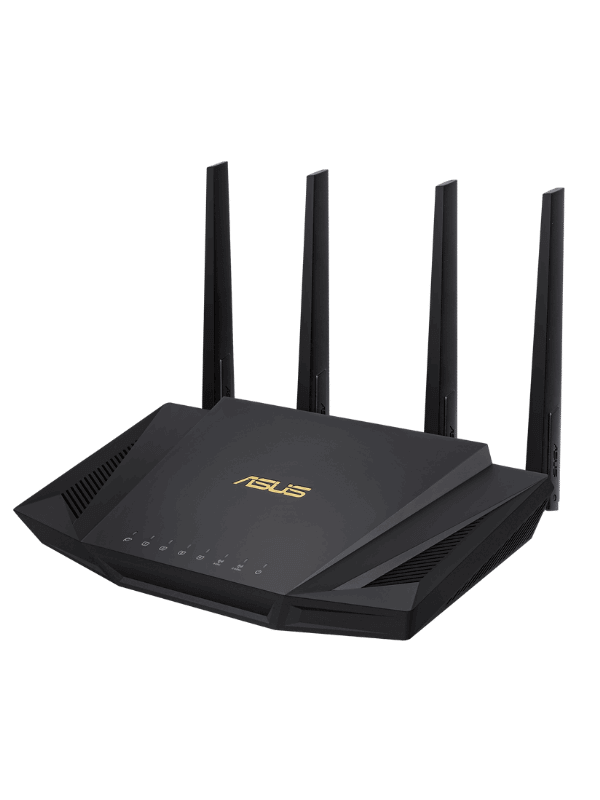
- Type: Wi-Fi router
- Tested max Wi-Fi speed: 889.41 Mbps
- Recommended for: plans up to 1000 Mbps
- Wireless standard: Wi-Fi 6
- Warranty: Two years
Pros
- Good performance
- Free app and security features
- Compact design
Cons
- Mediocre range
- No multi-gig ports
The cream of the crop right now is the ASUS RT-AX3000, otherwise known as the RT-AX58U. This fantastic router offers the best value for money for any router on the market in our eyes. Let us explain.
This mid-range (price-wise) router managed to clock an immense download speed of 889.41 Mbps when we tested it over Wi-Fi from 5ft away. That’s mighty impressive, let alone for its solid price. 800 Mbps speeds are enough for pretty much anyone, really.
But you don’t have to stay super close to this router in order to get good speed from it. We found that it clocked a speed of 415.11 Mbps when we ran our test again from 50ft away. That’s great speed from a distance.
In its overall range, the RT-AX3000 is a little average. We measured it to be 85-90ft, about enough for a medium-sized home. But that’s not so much of an issue as you can easily extend the range using ASUS’s AiMesh technology.
AiMesh allows you to add Mesh satellites to your network, extending the range but staying connected to the same network so that you don’t need to reconnect to a new network every time you go out of range of the original signal. A very handy tool indeed.
And there are more good features to talk about too. For example, when you buy the RT-AX3000, you get AiProtection Pro free for life. This is ASUS’s antivirus technology and parental controls so you can keep the network and the users on it safe at all times.
ASUS also offers a good warranty on its products of two years, the RT-AX3000 included. This means you’ll get double the coverage of the legal minimum in the US of one year for even more peace of mind.
For anyone with internet plans up to 1000 Mbps, this could well be the perfect router. And you won’t exactly need to take out a loan to buy it either. There isn’t anything we don’t love about this router other than the slight lack of base range, but that can be easily forgiven.
#2 Best for budgets: TP-Link Archer AX10
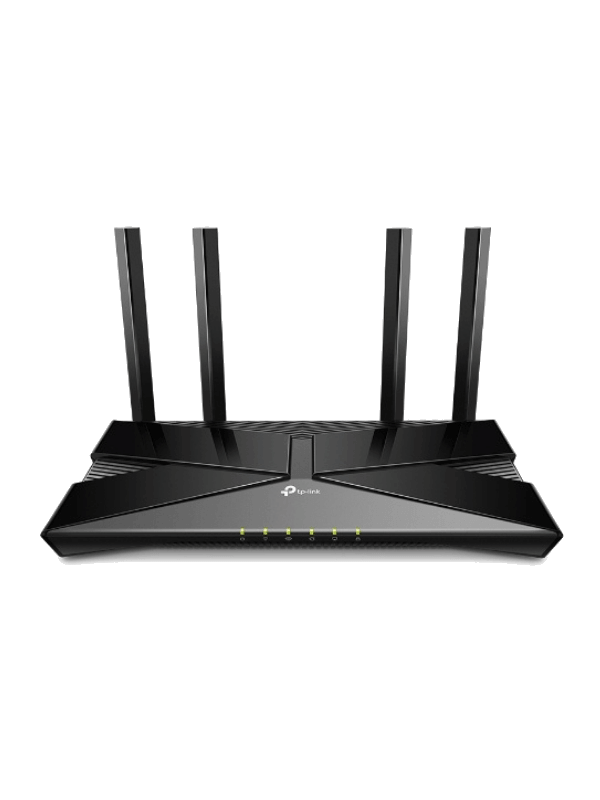
- Type: Wi-Fi router
- Tested max Wi-Fi speed: 651.97 Mbps
- Recommended for: plans up to 600 Mbps
- Wireless standard: Wi-Fi 6
- Warranty: Limited lifetime
Pros
- Strong speed for the price
- Reasonable range
- Smart features
Cons
- No USB ports
Looking to save a little cash on your next router purchase? We don’t blame you, and we have just the option for you. The TP-Link Archer AX10 is the best budget router in our eyes.
You might think that for a low price, you’ll get low speeds. But the AX10 proves that this doesn’t have to be the case. We managed to get a speed of 651.97 Mbps out of it. That’s a lot faster than some more affordable routers.
In terms of range, the AX10 isn’t bad either. We figured out that it can hold a signal up to 80-90ft. That’s about the size of a medium-sized home. However, you will need to use a traditional Wi-Fi extender if you want to go further as this router doesn’t support Mesh.
Some of the other features are a little limited to as you might expect from a budget router. The parental controls and QoS are quite limited so you won’t be able to restrict network access to vulnerable users or boost power for certain users quite as easily as with some routers.
There are also no USB ports on this router which means you won’t be able to plug in any external hardware. This might not be problematic for some, but it could also put a few people off altogether.
However, one of our favorite things about the AX10 is that, like with many TP-Link routers, you get a limited lifetime warranty. This means you’re covered for any faults for as long as you own the product. Relaxing!
Overall, the AX10 offers really great value for money. It’s super rare to get this much power out of such an affordable router. Hats off to TP-Link with this one!
#3 Best performer: Netgear Nighthawk RAXE500
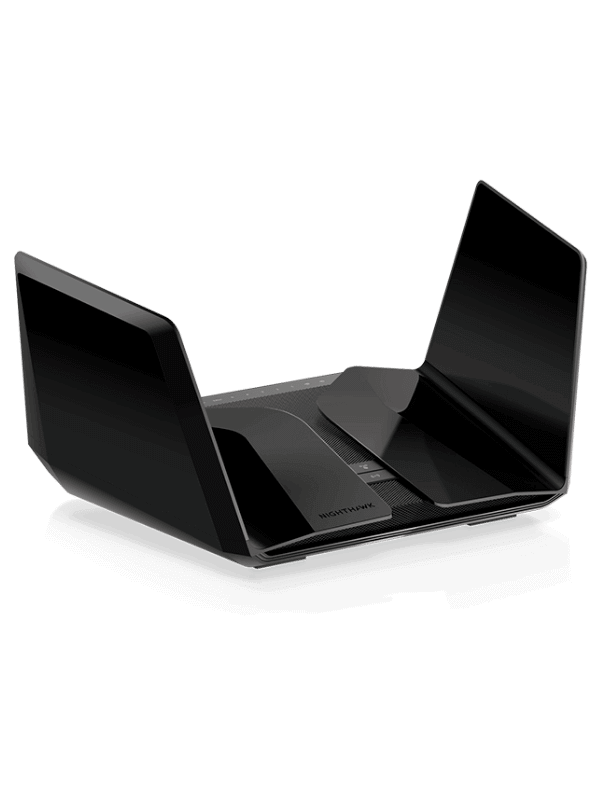
- Type: Wi-Fi router
- Tested max Wi-Fi speed: 1203.59 Mbps
- Recommended for: plans up to 1200 Mbps
- Wireless standard: Wi-Fi 6e
- Warranty: One year
Pros
- Very fast
- Good range
- Tri-band for more bandwidth
Cons
- Expensive
- Lacking features
Anyone wanting to max out their Gigabit internet plan over Wi-Fi should look no further than the Netgear Nighthawk RAXE500. This is one of the fastest home routers in the world right now, hence why we’ve picked it as our best performer!
When testing the Wi-Fi speed of this thing from 5ft away, we clocked a whopping 1203.59 Mbps. Anything over 1000 Mbps is ludicrously fast so if it is raw performance you’re looking for, this is the one for you.
The reason for this immense speed is Wi-Fi 6e technology. Here, a third band is added on top of the standard 2.4 GHz and 5 GHz ones: a 6 GHz one. This band has a shorter range than the other two but the fastest performance, hence the epic speeds.
The overall range of the router is still good though thanks to a powerful 2.4 GHz band. We found it to be between 100 and 110ft. That should cover a medium-large sized home with ease! Plus, you can extend that further seamlessly thanks to the Nighthawk’s built-in Mesh capabilities.
The features, however, are a tiny bit disappointing, especially considering you will have to pay an arm and a leg to buy this router. There is literally no QoS which is odd. That means you won’t be able to divert network power to particular devices as and when you need to.
Plus, the parental controls are limited. There’s no way to schedule parental controls to come on at particular times which some users will certainly find annoying.
There’s also only one year of warranty compared to the two or even lifetime that some other manufacturers offer. That shouldn’t have to be a problem as this router appears to be reliable, but those concerned about reliability may not like the sound of the lack of warranty.
So, for pure power, the Nighthawk is the best. But you will have to sacrifice on features and pay a lot of money to buy it. A good router for Gigabit internet plans.
#4 Best Mesh system: ASUS ZenWiFi AX AX6600
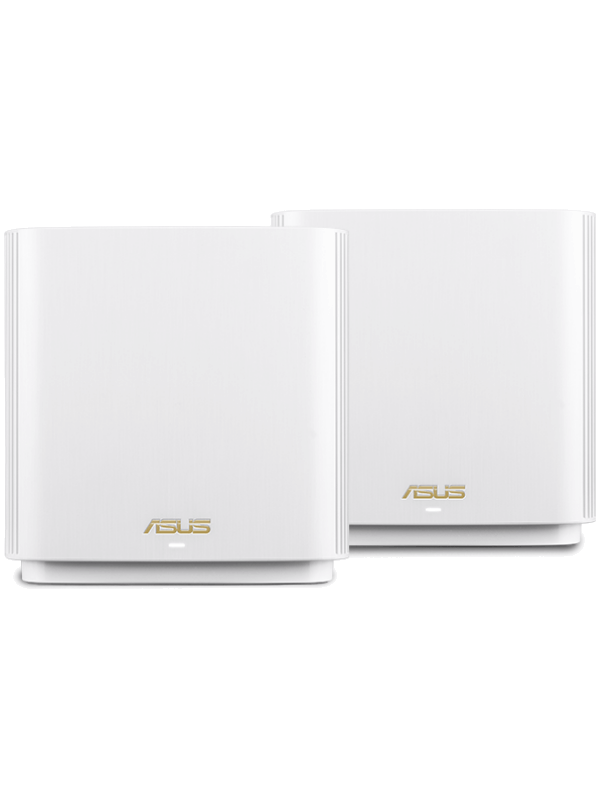
- Type: Wi-Fi Mesh router
- Tested max speed: 836.45 Mbps
- Recommended for: plans up to 800 Mbps
- Wireless standard: Wi-Fi 6
- Warranty: Two years
Pros
- Fast speed
- Great range
- Tri-band for more bandwidth
- Useful features (QoS, Parental Controls, etc)
Cons
- Slower 2.4 GHz band
- No WPA3 security
If it’s Mesh you’re after, your first port of call should be the ASUS ZenWiFi AX AX6600. It is, in our eyes, the best Mesh system on the market.
Mesh allows you to add extra satellites to your home network without the need for net network names. This means you’ll never have to drop a connection as you move around your (large) home. Mesh, therefore, is perfect for those with a home of 3000 sq. ft. or more.
And the ASUS ZenWiFi is up to the job. It’s super quick, with speeds as high as 836.45 Mbps in our tests. And it holds onto its speed as well. From 50ft away the speed we clocked was 575.15 Mbps. This is all the more important for Mesh as it allows for extra power for each satellite as you move further and further away from the original router.
Speaking of range, the range of each satellite node is very good. For the starter pack (two nodes), you can go as far as 200ft away from the original router and still hold a connection. Each of them has a range of about 100ft.
Part of what helps the performance of this system is that it is tri-band. So, there’s an additional 5 GHz band on top of the standard 2.4 Ghz and first 5 GHz ones. This frees up bandwidth on the 5 GHz bands to allow for more devices to get high speeds when connected to it.
It’s affordable, too. There are more powerful Mesh systems out there but in our eyes, ZenWifi offers the best value for money. Another part of the reason for our thinking there is the features.
And perhaps the best of those is AiProtection Pro. ASUS’s antivirus and parental controls feature comes free for life, meaning you can protect your network and the users on it.
You’ll get two years of warranty instead of the standard one to top that all off. This really is a faultless Mesh system and one that should be seriously considered by anyone with a large home.
#5 Best budget Mesh system: TP-Link Deco AX20 AX1800
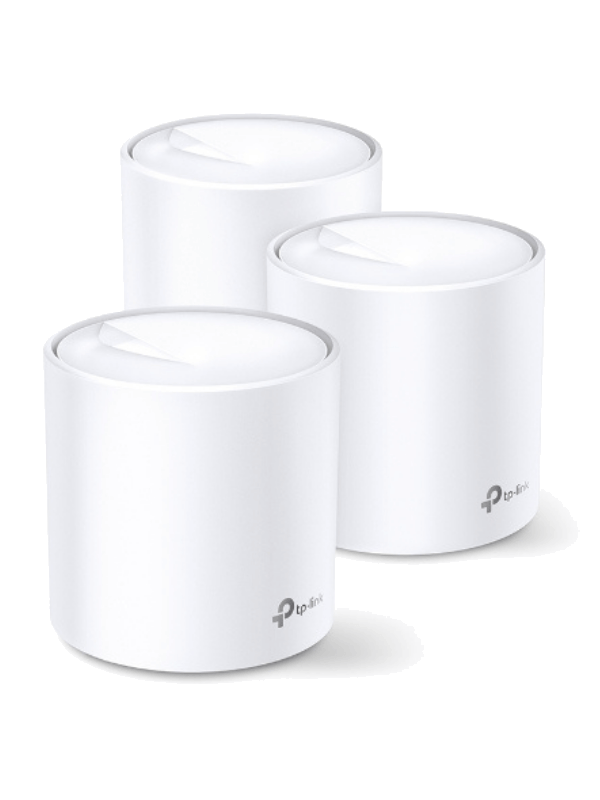
- Type: Wi-Fi router
- Tested max Wi-Fi speed: 695.05 Mbps
- Recommended for: plans up to 600 Mbps
- Wireless standard: Wi-Fi 6
- Warranty: Two years
Pros
- Quick speed
- Excellent range
Cons
- Slower 2.4 GHz band
Who’d have thought you could get a Wi-Fi 6 Mesh system on a budget? The introduction of the TP-Link Deco AX20 proved that it could be possible. That would’ve been unthinkable just a few years ago.
And it’s a very strong Mesh system as well. We clocked in at a top speed of 695.05 Mbps in our 5ft test. That makes this a great router for those with internet plans of 600 Mbps or less.
The range of each satellite isn’t as good as the ZenWiFi we just mentioned but it’s still not bad at all. We found that it came to around 90-95ft. You can buy a two-pack or a three-pack to get started, so use this range info to work out what’s best for you for the size of your home.
There are also a couple of cool features worth noting here. Firstly, you’ll get TP-Link’s Homeshield antivirus software when you buy this system. That’s free antivirus technology to fight off outside threats.
Furthermore, you can control the settings of this router (such as parental controls and QoS) using your voice thanks to Alexa compatibility.
TP-Link offers two years of warranty for its Mesh systems as opposed to the limited lifetime for its standard routers but that’s still double the amount of some of the competition so we’re happy with this overall.
Considering that this is a budget Mesh system, it offers a lot of power and some great features. And that is why it’s found its way to the position of best budget Mesh system in our list today.
#6 Best for gaming: ASUS RT-AX86U
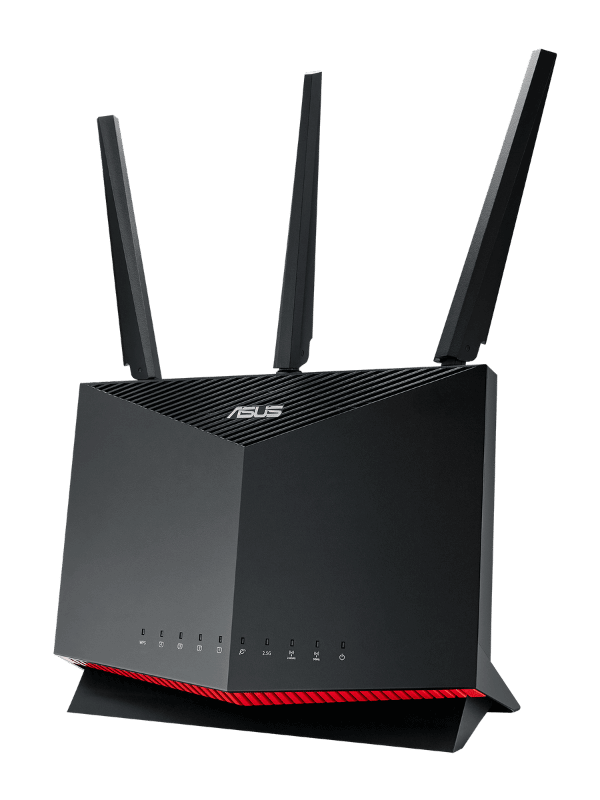
- Type: Wi-Fi router
- Tested max Wi-Fi speed: 784.09 Mbps
- Recommended for: plans up to 1000 Mbps
- Wireless standard: Wi-Fi 6
- Warranty: Two years
Pros
- Great value router
- Wide range
- Top tier features
Cons
- Slightly bulkier
We listed the ASUS RT-AX3000 as our best router, but there’s actually a higher calibre model in the range: the RT-AX86U.
Interestingly, the more affordable RT-AX3000 is faster than the RT-AX86U. Our 5ft speed test resulted in a top speed of 784.09 Mbps from this router. It’s still quick, but strangely not as quick. 784 Mbps is still plenty for most users though.
However, the range of this thing is better. We found that it could maintain a strong connection at 100-110ft. So, if you’re gaming far away from the router or if you have multiple gamers in the home, this might be the better option. A great option for medium-large sized homes.
You can give that a boost if you so wish thanks to AiMesh. This feature means you can connect Mesh satellites to your home network, giving you the chance to extend the range seamlessly.
The RT-AX86U is our best router for gaming because it combines great power and range with an awesome feature: adaptive QoS. This allows you to set a ‘gaming’ mode to your console of choice.
This will give more network attention to that console, lowering latency and improving speed for intense gaming sessions. It’ll also help with downloading large files, and any gamers will know how big a game file can be!
Sure, the RT-AX3000 has adaptive QoS as well but the bit of extra power of this router should make the RT-AX86U a little better for it. But you do have to pay. This router is a lot more expensive.
For the record, you can also opt for the RT-AX88U but honestly, we don’t feel it’s worth the big jump up in price from the RT-AX86U. This router is more than enough for even the most intense gamers out there.
#7 Best for security: ASUS RT-AX55
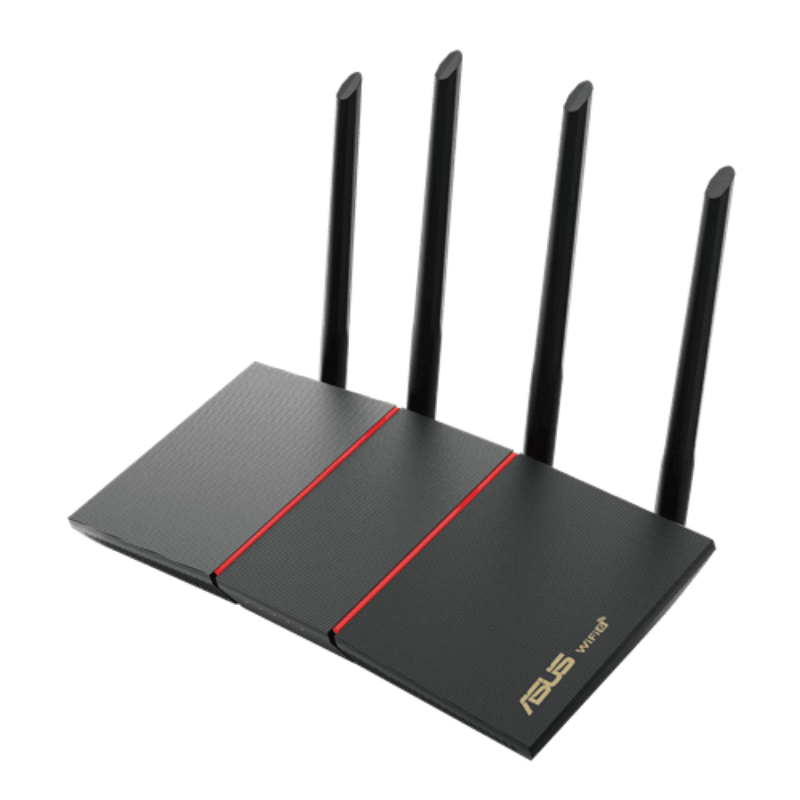
- Type: Wi-Fi router
- Tested max Wi-Fi speed: 401.76 Mbps
- Recommended for: plans up to 300 Mbps
- Wireless standard: Wi-Fi 6
- Warranty: Two years
Pros
- Pretty good range
- Good features
- Affordable
Cons
- A bit slow
If you want great security in your router and have an internet plan of up to 300 Mbps, definitely check out the ASUS RT-AX55.
In our speed test, the RT-AX55 was a little slow. It only managed 401.76 Mbps which means it is beaten by some more affordable routers out there. The range makes up for this somewhat, however, as this router can sustain a connection at 80-90ft.
You can go further than that without having to add an extra network name too. That’s because the RT-AX55 is fitted with AiMesh technology, making it one of the most affordable Mesh-ready routers on the market.
ASUS tick a lot of boxes with their routers and you might have noticed so far that security is one of them thanks to AiProtection Pro. But you don’t need to go for one of their more expensive offerings in order to get it. The fairly cheap RT-AX55 has it too.
AiProtection Pro is a bundle of antivirus technology and parental controls from ASUS that you get free for life when you purchase any of their routers. This means you’ll be able to protect both your network devices and the people using them!
Extra cool features here include adaptive QoS. This allows you to set modes to individual devices on the network to help them perform better in certain ways, such as gaming mode for a console.
Just like with any other ASUS router, you’ll get two years of warranty. That’s double what some manufacturers have to offer.
Other than the slight lack of speed, there isn’t much you won’t like about this router. So if you have an internet plan up to 300 Mbps and you want an extra level of security, take a close look at this one.
#8 Best for warranty: TP-Link Archer AX21
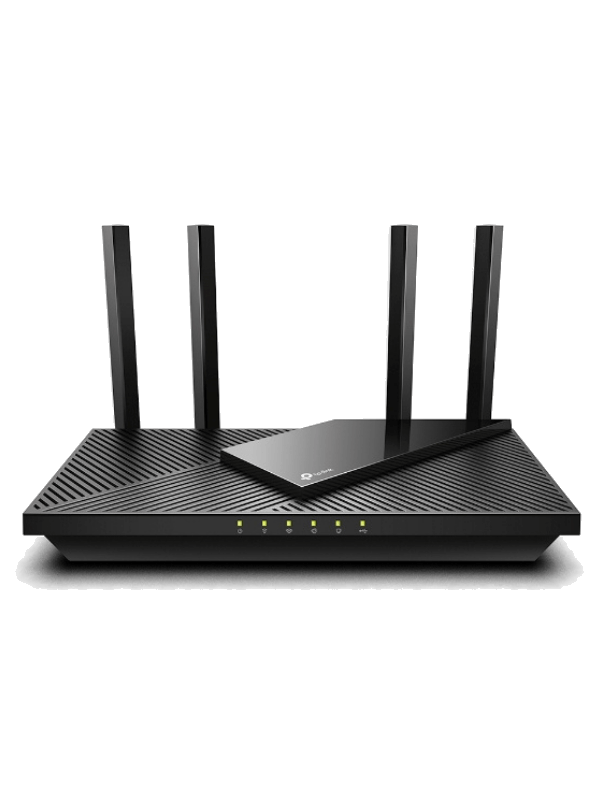
- Type: Wi-Fi router
- Tested max Wi-Fi speed: 675.08 Mbps
- Recommended for: plans up to 600 Mbps
- Wireless standard: Wi-Fi 6
- Warranty: Limited lifetime
Pros
- Amazing value for money
- Decent range
- Long warranty
Cons
- Could be cheaper
- HomeCare subscription for extra features
We love that TP-Link gives lots of their routers lifetime warranty and one of the most affordable ways to get this is through the TP-Link Archer AX21.
Even though this is a low priced router, it performs pretty well. We managed a download speed of 675.08 Mbps from 5ft away which isn’t bad at all. At that speed, a whole family or even a small workplace could use the internet at the same time and heavily.
The range is impressive for a budget router too. You’ll still be able to get a connection from as far as 90-100ft away from this router. That’s effectively the size of a medium-large sized home. You’ll need to use a Wi-Fi extender to boost that range as there are no Mesh capabilities with this router.
In terms of features, there is QoS on this router although it is a bit limited. You’ll still be able to prioritize a handful of devices to get more network attention this way though. Plus, you can restrict access to certain content using parental controls.
If you want to upgrade your parental controls and get antivirus technology, you’ll need to pay to subscribe to TP-Link HomeCare. It is a shame you have to pay for this considering ASUS offers something for free with their routers. But, it is still a cheap router so we’ll forgive them.
Other than that, there isn’t really anything to dislike about this router. It’s a really strong option for the warranty-minded who have internet plans up to 600 Mbps.
#9 Best for extra features: Google Nest Wi-Fi

- Type: Wi-Fi router
- Tested max Wi-Fi speed: 87.76 Mbps
- Recommended for: plans up to 100 Mbps
- Wireless standard: Wi-Fi 5
- Warranty: Two years
Pros
- Affordable
- Looks great
- Great features with Home integration
Cons
- Poor performance
Time for something a little different. Our favorite router for extra features is Google Nest Wi-Fi. That’s because it integrates beautifully with smart home objects. That’s the future, right there!
You will have to compromise quite substantially on performance if you like the sound of this system though. Because this is a Wi-Fi 5 router rather than a Wi-Fi 6 one, it’s slow. In fact, it’s slow even for Wi-Fi 5.
We only managed a download speed of 87.76 Mbps from it. That’s just about enough for a single user or a couple but a whole family might struggle to get what they need from the network at this speed.
It’s not all bad though. It’s a pretty affordable system all things considered and the range isn’t awful. The original router comes in at 80ft with each node added giving an extra 50ft. So even with the base pack, you’re covering 130ft which is a large home and then some.
But what we really like about Google Nest Wi-Fi is the fact that it integrates so neatly with other Internet of Things (IoT) devices. So if you have smart lighting, a Nest thermostat or any other device like that then Nest is a great way to tie everything together in combination with the Google Home app.
On top of that, each of the Google Nest Wi-Fi nodes doubles up as a smart speaker and voice assistant so you can control all the network settings plus every IoT device connected to it with speech.
If you want Google Home integration like this and you feel like you can live with the slow speed then Google Nest Wi-Fi might be the best option for you.
Router Buying Guide
The way we ranked our routers is based on a series of criteria, and you can use these to make a better decision as to which router to go for when you come to upgrade. So let’s check them out.
We go into more detail with our ultimate router buying guide if you need more info after this, but you should find the main talking points coming right up.
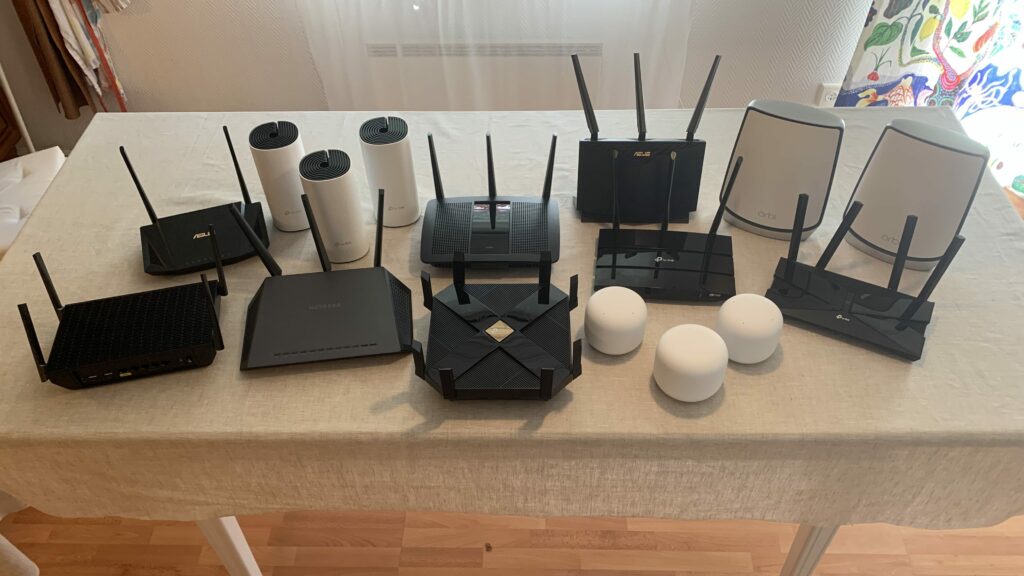
Wi-Fi 5 vs Wi-Fi 6
The Wi-Fi protocol you opt for in your next router should reflect the internet plan you have at home, and to some extent the size of your home.
Every few years, a new Wi-Fi standard is released. Each time, it brings new Wi-Fi technologies and therefore faster performance and usually a wider range.
Wi-Fi 5 was released quite a few years back. It does have the potential to perform well but Wi-Fi 6’s release in 2019 blew it out of the water. It has the potential to be 250% faster and with a slightly wider range.
Generally, if you have an internet plan of 200 Mbps or less, Wi-Fi 6 will not be worth it. Plus, not all devices support Wi-Fi 6 yet so those with older devices might be better off with Wi-Fi 5 as well.
For more information on the differences between Wi-Fi 5 and Wi-Fi 6, you can read our more detailed comparison of the two.
What about Wi-Fi 6e?
Now, there’s also Wi-Fi 6e. This technology sees the addition of a third band on top of the standard 2.4 GHz and 5 GHz. The third band of 6 GHz has a narrow range but even more speed potential. It can easily achieve speeds of well over 1000 Mbps!
So if you have a Gigabit internet plan, Wi-Fi 6e could well be worth it. If you don’t, it probably won’t as Wi-Fi 6e routers are a lot more expensive. Furthermore, not many devices support Wi-Fi 6e yet so make sure you check your device compatibility before you commit.
More on tri-band routers
Wi-Fi 6e’s 6 GHz band is not the only example of a router with three bands, or a tri-band router. There are also some devices that offer a second 5 GHz band. But why?
Tri-band routers are actually quite a clever way to get better network performance for many devices. It frees up space on the band meaning more devices can get better speeds from it.
So, overall, tri-band routers are worth it for those looking to connect lots of devices to their network, but only if they are devices that support 5 GHz connections.
Mesh or no Mesh?
We’ve mentioned a handful of Mesh systems today but the big question is: when is Mesh worth it? In general, we recommend Mesh to anyone with a home of over 3000 sq. ft.
Mesh allows you to extend the range of your home network by adding additional satellite nodes that stay on the same network as opposed to creating a new network name. This means you’ll be able to move around a large space and stay constantly connected.
But would you be better off saving some money and opting for a standard Wi-Fi repeater? We compared the options here.
Additional Wi-Fi technologies
With Wi-Fi 6, a few new exciting Wi-Fi technologies were developed: MU-MIMO, OFDMA, and beamforming.
MU-MIMO goes hand in hand with OFDMA to help connect to multiple devices simultaneously and improve their performance. MU-MIMO does this by using the router’s beams to seek out individual devices, resulting in less wasted streams. OFDMA achieves a similar result by assigning sets of subcarriers to the devices.
Any user who wants to connect a lot of devices to their network at the same time should consider a router that has these technologies.
Beamforming should also be considered as it improves connection times and network speeds. It achieves this in a similar way to MU-MIMO in that it channels the energy of each of the router’s beams to divert more power to individual devices.
Extra router features
There are a couple of extra features that are definitely worth considering taking up with your next router: QoS and parental controls.
The first of these, QoS (short for Quality of Service), allows you to pick a handful of devices on the network to divert more network attention to. This means they’ll get better speeds and low latency. That’s really useful for things like large file downloads or intense gaming sessions.
Parental controls, on the other hand, restrict access to certain content for certain users. So if you have young children in the home, this is really useful to keep their eyes away from inappropriate or harmful content.
It’s also worth noting that some routers these days feature compatibility with voice assistants. This allows you to control QoS, parental controls, and other network settings with your voice which makes things quicker, so this could be worth considering as well.
Security and warranty
The last couple of things that we feel are really important for protecting your router and home network are security and warranty.
A lot of routers these days come with free antivirus technology and some make you pay for a subscription to get it. Either way, it should be done. If your router is hit with a virus, it can compromise the security of every single device that’s connected to it.
So, we recommend always opting for a router that has antivirus technology.
The minimum legal warranty in the US is one year, so you’ll never find a router that offers less than this. However, some manufacturers offer a lot more. For example, all ASUS products have a minimum of two years. TP-Link goes further by offering a limited lifetime warranty on a lot of their routers.
Why is this important? Because if there is an issue with your router, you’ll be covered. If your router has a one-year warranty but breaks down after 13 months, you’ll need to buy a new one. If it has a limited lifetime warranty, you’re covered for as long as you own it.
Why You Can Trust Us
Here at Networks Hardware, we pride ourselves on how we test the routers we recommend to our readers. We want to make sure that we deliver first-hand, accurate information about every router we discuss. So, we make sure we find out everything we feel you need to know ourselves rather than taking anybody else’s word for it.
In our ‘Networks Hardware top-secret testing facilities’, we put each of the routers through a series of tests to find out their range and performance at different intervals using the Ookla speed test.
Then, we check out all of the features of the routers (including QoS, parental controls, and more) to find out how good they are.
With all that in mind, we can provide a clear picture of exactly how good a router is. And that’s why we’re so confident that we’ve got our top picks right today.
Best Router FAQ
Of course, there are going to be a lot of questions when discussing the best routers, so here are some of the most frequently asked of those.
Which other hardware will I need?
If you have fiber optic internet, you can just plug your router right in and go. However, those with cable broadband will also need a modem, otherwise they will not be able to get an internet connection.
Don’t worry though. Buying a cable modem does not have to be difficult. We’ve put together a few of the best ones to make your life easier in that respect.
Which is the fastest router going?
Because of the 2021 release of Wi-Fi 6e, Wi-Fi routers are now faster than ever. With routers such as the Netgear Nighthawk RAXE500 on the market, it’s possible to get download speeds of way over 1000 Mbps for the first time.
But remember, your router is only ever going to be as fast as your home internet plan. If you have a service plan of 200, 500 or even 800 Mbps, there’s not much point going for the Netgear Nighthawk RAXE500. It’s not going to make any difference!
Should I hold out for a Wi-Fi 7 router?
Early reports of Wi-Fi 7 have begun to come in and it’s very exciting indeed, to say the least! Wi-Fi 7 has the potential to be substantially faster than even Wi-Fi 6e, so we cannot wait to try it out.
That being said, it might still be a while before Wi-Fi 7 becomes readily available. Early speculation puts a date of late 2023 or early 2024 on it, and that could even be a little on the ambitious side. So if you need a super-fast router now, Wi-Fi 6 or Wi-Fi 6e are your best bets.
A Few Last Thoughts on the Best Routers in 2022
So there we have it! Our top routers in the world right now are in a number of different areas. We found that the absolute best router going right now in terms of what you get for what you pay is the ASUS RT-AX3000. It’s a beautiful machine and will be perfect for a lot of people.
But not all people. Some of our readers may well be off with a different device based on their personal circumstances. So don’t just take our word for it right off the bat! Check out the rest of our recommendations and see if there is one that’s better suited to you.

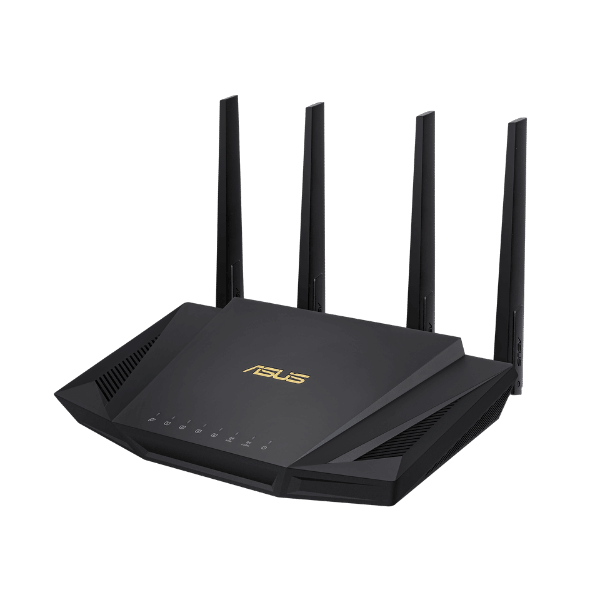
2 thoughts on “Best Routers”
If the Asus RT- AX3000’s main drawback is it’s shorter range, why is it not featured in the apartment routers list? Is there something that would make you prefer the AX50/55 from tp link for small homes/apartments?
Hi Isaac,
Looking back at the list, I definitely agree with you. The RT-AX3000 would make a lot of sense as an option for anyone living in an apartment.
That being said, I think the AX50 is a more all-around option, with slightly lower speed but a better range (I do agree that the coverage might not be as important in an apartment, even though this depends on the size). The difference is tangible, and thus we choose to go with the AX50 instead.
But if you live in a smaller apartment, the RT-AX3000 is a great option!